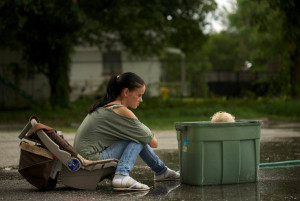Homeless Families in America.
How do we take care of our most valuable and vulnerable assets.
For Kayla, 12, and her brothers, Kyle and Mitch ages 7 and 3, respectively, it happened after their mother had been in a car accident. Katherine, a single mother of three, living from pay check to pay check and sometimes having to take on two jobs to support the family, she was doing her best to raise her children as kind, understanding, and compassionate. Knowing her situation was volatile, she always took the opportunity to use it as a teachable moment, to show her kids that they could get through anything as long as they work hard and stick together. Then came the car accident. By no fault of her own, the course of her and the children’s life would be changed instantly and without warning due to an unaware driver running a red light and demolishing the car she was already struggling to pay for. A hospital stay and a damaged car beyond repair led to a set of circumstances beyond her control. Loss of a job and a pile of bills with no way to pay them, she barely had enough money to feed her kids let alone the money for bus fair or a babysitter so that she could go out and search for new employment. This downward spiral would soon lead to eviction and homelessness for this family of four. Without the time, money, or resources necessary to combat this overwhelming situation, she was forced to pack what clothes and essentials could fit into four small back packs and find some way to move forward.
As with so many families and children who become the victims of these unforeseen situations that are beyond their control, homelessness is just one unfortunate circumstance away. Serious illness, accident, or a death in the family can put many of these individuals at great risk of not being able to make ends meet when tragedy strikes. Due to the lack of affordable housing, decreasing government supports, combined with an unsteady job market, many of the challenges facing today’s families are forcing them to live a fine line between poverty and homelessness. Those most profoundly affected are the children in these families, the most vulnerable and in need of our help. It is our obligation to help take care of these children, again, the most vulnerable, most promising young lives the future has to offer. Many of these children are being raised by a single mother who is often times the victim of domestic violence, physical, and mental abuse. Left on their own to raise a family, many of these women must take on two or three jobs just to keep a roof over their heads and put food on the table. Without an adequate support system, many are pushed to the brink by the stress and uncertainties caused by living pay check to pay check, meal to meal. All of this is unintentionally passed on to the children who witness and live through these struggles. Many reports show that the children who experience these type of unstable living conditions grow up with post-traumatic stress disorder, depression, chronic health issues as well as mental health issues.
Although the federal government has taken great effort to bring down the number of chronically homeless individuals and veterans, children and families have not received the same benefits, and their numbers are rising. According to The National Alliance to End Homelessness, 564,708 people were homeless on a given night in 2015. Of that number, 206,286 were people in families, and 358,422 were individuals. About 15% of that population, 83,170, are what’s considered chronically homeless individuals. These chronically homeless individuals are what most of us see as the national face of homelessness, the unwashed, unkept, and foul smelling human beings commonly referred to as bums, or bag-ladies. In realty these homeless are commonly the victims of mental and physical abuse, sufferers of mental illness, and most times at the mercy of an alcohol and/or drug addiction. As a society, we have grown accustomed to the homelessness that surrounds us. Usually with little more than a glance, we walk by them, ignoring their pleas for help or spare change, pretending not to hear them. We pretend not to see them, looking down at our cell phones as if there something important pending or looking away as if something has caught our eye, any reason to not acknowledge or make eye contact with them.
However, amongst the four categories of homeless recognized by the National Alliance to End Homelessness, (Families, Veterans, Chronic, and Youth), it is Youth homelessness, a mostly silent and mostly invisible majority that posts the most surprising and staggering statistics. Of the numbers of homeless children ages 1-17, 51 percent are under the age of six, and the disheartening list goes on. 1 in 45 children, or rather 1.6 million kids will experience homelessness, and nearly 40 percent of the homeless population are under the age of 18. According to Covenant House, a privately funded agency providing food, shelter, and crisis care to homeless and runaway youth, 41% of homeless kids witnessed acts of violence in their homes, 36% indicated that someone in their family used drugs regularly, 19% reported being beaten with an object, 19% reported that they have endured sexual abuse, and 15% reported that someone close to them had been murdered. Of all the research conducted by various homeless advocacy groups, the Covenant House statistics concluded that without decisive action and the allocation of sufficient resources, the nation will fail to reach the stated federal goal of ending family homelessness by 2020, and child homelessness may result in a permanent Third World in America.
So much more can and must be done to help and aid these families and the children who are at great risk of the consequences that accompany an uncertain future. On April 29th over 180 women in five cities across the country slept on the streets with a goal of raising $345,000 for the homeless youth at Covenant House. The third annual Sleep Out: Mothers Edition included moms, grandmothers, aunts, foster moms — women who care about kids and want to make a difference. As stated by Covenant House President Kevin Ryan, “The amazing women participating in this Covenant House Sleep Out are sending a loud and clear message to homeless kids – that we stand with them in their struggles, and celebrate their courage, their resiliency, and their dreams for a better life, what a beautiful message to send as Mother’s Day approaches.”
There is no singular image to portray homelessness in this country. Within the four recognized categories of homelessness, Chronic, Families, Youth, and Veterans, individuals of all ages, geographic areas, occupations, and ethnicities are affected. To think of these homeless individuals as lazy, addicts, or have somehow brought this on themselves or that they choose to be homeless is an absurd and careless notion. This is not a choice and to assume so is ignorant and wrong.
As covenant house has stated, the issues surrounding childhood homelessness reach far beyond just providing hot meals, a warm shower, and a clean bed, there is a wide range of deep-seated psychological, physical, and economic reasons for youth homelessness. The list of unthinkable situations these children are put in are endless. It’s sickening, sad, and heartbreaking to know that these young lives, full of imagination, adventure, and hope are forced to experience the fear, shock, and dismay caused by homelessness and by no will or fault of their own. These homeless families with young children are at a risk different from other homeless and therefore must be treated differently for these needs and risks.
As for Katherine and her three children, Kayla, Kyle and Mitch, their situation has changed. But one wonders at what unnecessary cost. Through guidance and a strong support system that included help from homeless advocates, complete strangers willing to give of their time, money and energy, Katherine and her children were able to bounce back and return to a life of somewhat relative normalcy. A stable job, new car, and a secure roof over their heads has provided a foundation on which to rebuild from. However, the damage done through this experience has left emotional scars and damage that will not soon heal in the minds of these young children, and these experiences manifest themselves in heartbreaking ways. Kayla, the oldest of her siblings is most definitely experiencing the symptoms of post-traumatic stress disorder and is displaying behavior most associated with a newborn baby. Her brothers, Kyle and Mitch are also showing similar signs of trauma, often waking up in the night screaming and crying due to nightmares, often asking their caring and comforting mother if they are at risk of becoming homeless again, fearing that it all could be taken away once more.
In the spirit of it takes a village, this crisis of family homelessness should be a call to arms for any and all individuals who not only have the time, money, and/or resources to contribute and help, but to those who have the empathy and compassion to make a difference in the lives of those living on the edge of poverty and homelessness, and the children who are the unwitting victims of a social system that contributes to living conditions far beyond the control or understanding of a child. The impact we can all have on a child’s sense of security and well-being is immeasurable. We are all capable of extraordinary behavior, going above and beyond when tragedy befalls our fellow human-beings. However, it is usually a catastrophic event out in the open that grabs us and pushes our instincts to help into action. With this problem, family and childhood homelessness, it is the most vulnerable and at risk members of our society who slip through the cracks and go unnoticed. We can all make a difference in the lives of these children. We are all somebody’s child.


